Aerosol Characterization of Northern China and Yangtze River Delta Based on Multi-Satellite Data: Spatiotemporal Variations and Policy Implications
Abstract
1. Introduction
2. Materials and Methods
2.1. Study Area
2.2. Staellite Data
2.3. Data Processing
3. Results
3.1. Temporal and Spatial Distribution of AOD
3.2. Vertical Distribution of Aerosol Extinction Coefficient
3.3. Spatial and Temporal Distribution of Aerosol Types
4. Discussion
4.1. Effects of Chinese Pollution Control Policies on the Aerosol Properties of TD, NCR, NCP, and YRD
4.2. Analysis of the Variation of Aerosol Properties in the Study Area by Longitude
5. Conclusions
Author Contributions
Funding
Data Availability Statement
Acknowledgments
Conflicts of Interest
References
- Jinxi, C.; Rong, L.; Minghui, T.; Lili, W.; Changqing, L.; Jun, W.; Lunche, W.; Yi, W.; Liangfu, C. Overview of the performance of satellite fire products in china: Uncertainties and challenges. Atmos. Environ. 2022, 268, 118838. [Google Scholar]
- Zhou, B.; Chao, Q.; Huang, L. The Core Conclusions and Interpretation of Working Group I Contribution to the Fifth Assessment Report of the Intergovernmental Panel on Climate Change. Chin. J. Urban Environ. Stud. 2015, 3, 1550003. [Google Scholar] [CrossRef]
- Ahn, S.H.; Yoon, Y.; Choi, T.; Lee, J.; Kim, Y.; Lee, B.; Ritter, C.; Aas, W.; Krejci, R.; Ström, J.; et al. Relationship between cloud condensation nuclei (CCN) concentration and aerosol optical depth in the Arctic region. Atmos. Environ. 2021, 267, 118748. [Google Scholar] [CrossRef]
- Charlson, R.J.; Schwartz, S.E.; Hales, J.M.; Cess, R.D.; Coakley Jr, J.A.; Hansen, J.E.; Hofmann, D.J. Climate forcing by anthropogenic aerosols. Science 1992, 255, 423–430. [Google Scholar] [CrossRef]
- Wei, X.; Chang, N.-B.; Bai, K.; Gao, W. Satellite remote sensing of aerosol optical depth: Advances, challenges, and perspectives. Crit. Rev. Environ. Sci. Technol. 2020, 50, 1640–1725. [Google Scholar] [CrossRef]
- Torres, O.; Tanskanen, A.; Veihelmann, B.; Ahn, C.; Braak, R.; Bhartia, P.; Veefkind, P.; Levelt, P.P. Aerosols and surface UV products from Ozone Monitoring Instrument observations: An overview. J. Geophys. Res. Atmos. 2007, 112, D24S47. [Google Scholar] [CrossRef]
- Jung, C.H.; Lee, J.Y.; Um, J.; Lee, S.S.; Yoon, Y.J.; Kim, Y.P. Estimation of Source-Based Aerosol Optical Properties for Polydisperse Aerosols from Receptor Models. Appl. Sci. 2019, 9, 1443. [Google Scholar] [CrossRef]
- Si, Y.; Chen, L.; Xiong, X.; Shi, S.; Husi, L.; Cai, K. Evaluation of the MISR fine resolution aerosol product using MODIS, MISR, and ground observations over China. Atmos. Environ. 2019, 223, 117229. [Google Scholar] [CrossRef]
- Wei, J.; Li, Z.; Sun, L.; Peng, Y.; Liu, L.; He, L.; Qin, W.; Cribb, M. MODIS Collection 6.1 3 km resolution aerosol optical depth product: Global evaluation and uncertainty analysis. Atmos. Environ. 2020, 240, 117768. [Google Scholar] [CrossRef]
- Huneeus, N.; Schulz, M.; Balkanski, Y.; Griesfeller, J.; Prospero, J.; Kinne, S.; Bauer, S.; Boucher, O.; Chin, M.; Dentener, F.; et al. Global dust model intercomparison in AeroCom phase I. Atmos. Meas. Technol. 2011, 11, 7781–7816. [Google Scholar] [CrossRef]
- Winker, D.M.; Hunt, W.H.; McGill, M.J. Initial performance assessment of CALIOP. Geophys. Res. Lett. 2007, 34, L19803. [Google Scholar] [CrossRef]
- IPCC; Stocker, T.F.; Qin, D.; Plattner, G.K.; Midgley, P.M. The physical science basis. In Contribution of Working Group i to the Fifth Assessment Report of the Intergovernmental Panel on Climate Change; Cambridge University Press: Cambridge, UK, 2013; p. 2013. [Google Scholar]
- Tomasi, C.; Kokhanovsky, A.A.; Lupi, A.; Ritter, C.; Smirnov, A.; O’Neill, N.T.; Stone, R.S.; Holben, B.N.; Nyeki, S.; Wehrli, C.; et al. Aerosol remote sensing in polar regions. Earth-Sci. Rev. 2015, 140, 108–157. [Google Scholar] [CrossRef]
- Xie, Y.; Li, Z.; Li, L.; Wagener, R.; Abboud, I.; Li, K.; Li, D.; Zhang, Y.; Chen, X.; Xu, H. Aerosol optical, microphysical, chemical and radiative properties of high aerosol load cases over the Arctic based on AERONET measurements. Sci. Rep. 2018, 8, 9376. [Google Scholar] [CrossRef]
- Prasad, A.K.; Singh, S.; Chauhan, S.; Srivastava, M.K.; Singh, R. Aerosol radiative forcing over the Indo-Gangetic plains during major dust storms. Atmos. Environ. 2007, 41, 6289–6301. [Google Scholar] [CrossRef]
- Soni, M.; Verma, S.; Jethava, H.; Payra, S.; Lamsal, L.; Gupta, P.; Singh, J. Impact of COVID-19 on the Air Quality over China and India Using Long-term (2009-2020) Multi-satellite Data. Aerosol Air Qual. Res. 2021, 21, 200295. [Google Scholar] [CrossRef]
- Bibi, H.; Alam, K.; Chishtie, F.; Bibi, S.; Shahid, I.; Blaschke, T. Intercomparison of MODIS, MISR, OMI, and CALIPSO aerosol optical depth retrievals for four locations on the Indo-Gangetic plains and validation against AERONET data. Atmos. Environ. 2015, 111, 113–126. [Google Scholar] [CrossRef]
- Ali, A.; Amin, S.E.; Ramadan, H.H.; Tolba, M.F. Enhancement of OMI aerosol optical depth data assimilation using artificial neural network. Neural Comput. Appl. 2012, 23, 2267–2279. [Google Scholar] [CrossRef]
- Hsu, N.C.; Lee, J.; Sayer, A.M.; Carletta, N.; Chen, S.; Tucker, C.J.; Holben, B.N.; Tsay, S. Retrieving near-global aerosol loading over land and ocean from AVHRR. J. Geophys. Res. Atmos. 2017, 122, 9968–9989. [Google Scholar] [CrossRef]
- Li, Y.; Shi, G.; Sun, Z. Evaluation and improvement of MODIS aerosol optical depth products over China. Atmos. Environ. 2019, 223, 117251. [Google Scholar] [CrossRef]
- Jääskeläinen, E.; Manninen, T.; Tamminen, J.; Laine, M. The Aerosol Index and Land Cover Class Based Atmospheric Correction Aerosol Optical Depth Time Series 1982–2014 for the SMAC Algorithm. Remote Sens. 2017, 9, 1095. [Google Scholar] [CrossRef]
- Zhu, J.; Xia, X.; Wang, J.; Che, H.; Chen, H.; Zhang, J.; Xu, X.; Levy, R.C.; Oo, M.; Holz, R.; et al. Evaluation of Aerosol Optical Depth and Aerosol Models from VIIRS Retrieval Algorithms over North China Plain. Remote Sens. 2017, 9, 432. [Google Scholar] [CrossRef] [PubMed]
- Bibi, S.; Alam, K.; Chishtie, F.; Bibi, H. Characterization of absorbing aerosol types using ground and satellites based observations over an urban environment. Atmos. Environ. 2017, 150, 126–135. [Google Scholar] [CrossRef]
- Sabetghadam, S.; Alizadeh, O.; Khoshsima, M.; Pierleoni, A. Aerosol properties, trends and classification of key types over the Middle East from satellite-derived atmospheric optical data. Atmos. Environ. 2020, 246, 118100. [Google Scholar] [CrossRef]
- Kumar, K.R.; Kang, N.; Yin, Y. Classification of key aerosol types and their frequency distributions based on satellite remote sensing data at an industrially polluted city in the Yangtze River Delta, China. Int. J. Clim. 2017, 38, 320–336. [Google Scholar] [CrossRef]
- Bilal, M.; Ali, A.; Nichol, J.E.; Bleiweiss, M.P.; de Leeuw, G.; Mhawish, A.; Shi, Y.; Mazhar, U.; Mehmood, T.; Kim, J.; et al. AEROsol generic classification using a novel Satellite remote sensing Approach (AEROSA). Front. Environ. Sci. 2022, 10, 981522. [Google Scholar] [CrossRef]
- Winker, D.M.; Vaughan, M.A.; Omar, A.; Hu, Y.; Powell, K.A.; Liu, Z.; Hunt, W.H.; Young, S.A. Overview of the CALIPSO Mission and CALIOP Data Processing Algorithms. J. Atmos. Ocean. Technol. 2009, 26, 2310–2323. [Google Scholar] [CrossRef]
- Tackett, J.L.; Winker, D.M.; Getzewich, B.J.; Vaughan, M.A.; Young, S.A.; Kar, J. CALIPSO lidar level 3 aerosol profile product: Version 3 algorithm design. Atmos. Meas. Technol. 2018, 11, 4129–4152. [Google Scholar] [CrossRef]
- Pan, H.; Huang, J.; Kumar, K.R.; An, L.; Zhang, J. The CALIPSO retrieved spatiotemporal and vertical distributions of AOD and extinction coefficient for different aerosol types during 2007–2019: A recent perspective over global and regional scales. Atmos. Environ. 2022, 274, 118986. [Google Scholar] [CrossRef]
- Mehta, M.; Singh, N. Anshumali Global trends of columnar and vertically distributed properties of aerosols with emphasis on dust, polluted dust and smoke—Inferences from 10-year long CALIOP observations. Remote Sens. Environ. 2018, 208, 120–132. [Google Scholar] [CrossRef]
- Yang, Y.; Zhao, C.; Wang, Q.; Cong, Z.; Yang, X.; Fan, H. Aerosol characteristics at the three poles of the Earth as characterized by Cloud–Aerosol Lidar and Infrared Pathfinder Satellite Observations. Atmos. Meas. Technol. 2021, 21, 4849–4868. [Google Scholar] [CrossRef]
- Gui, L.; Tao, M.; Wang, Y.; Wang, L.; Chen, L.; Lin, C.; Tao, J.; Wang, J.; Yu, C. Climatology of aerosol types and their vertical distribution over East Asia based on CALIPSO lidar measurements. Int. J. Clim. 2022, 42, 6042–6054. [Google Scholar] [CrossRef]
- Chen, S.; Huang, J.; Li, J.; Jia, R.; Jiang, N.; Kang, L.; Ma, X.; Xie, T. Comparison of dust emissions, transport, and deposition between the Taklimakan Desert and Gobi Desert from 2007 to 2011. Sci. China Earth Sci. 2017, 60, 1338–1355. [Google Scholar] [CrossRef]
- Nan, Y.; Wang, Y. De-coupling interannual variations of vertical dust extinction over the Taklimakan Desert during 2007–2016 using CALIOP. Sci. Total. Environ. 2018, 633, 608–617. [Google Scholar] [CrossRef]
- Liu, G.; Li, J.; Jiang, Z.; Li, X. Impact of sea surface temperature variability at different ocean basins on dust activities in the Gobi Desert and North China. Geophys. Res. Lett. 2022, 49, e2022GL099821. [Google Scholar] [CrossRef]
- De Leeuw, G.; Sogacheva, L.; Rodriguez, E.; Kourtidis, K.; Georgoulias, A.K.; Alexandri, G.; Amiridis, V.; Proestakis, E.; Marinou, E.; Xue, Y.; et al. Two decades of satellite observations of AOD over mainland China using ATSR-2, AATSR and MODIS/Terra: Data set evaluation and large-scale patterns. Atmos. Meas. Technol. 2018, 18, 1573–1592. [Google Scholar] [CrossRef]
- Kang, N.; Kumar, K.R.; Hu, K.; Yu, X.; Yin, Y. Long-term (2002–2014) evolution and trend in Collection 5.1 Level-2 aerosol products derived from the MODIS and MISR sensors over the Chinese Yangtze River Delta. Atmos. Res. 2016, 181, 29–43. [Google Scholar] [CrossRef]
- Kang, H.; Zhu, B.; Liu, X.; Shi, S.; Hou, X.; Lu, W.; Yan, S.; Pan, C.; Chen, Y. Three-Dimensional Distribution of PM 2.5 over the Yangtze River Delta as Cold Fronts Moving Through. J. Geophys. Res. Atmos. 2021, 126, e2020JD034035. [Google Scholar] [CrossRef]
- Liu, C.; Shen, X.; Gao, W. Intercomparison of CALIOP, MODIS, and AERONET aerosol optical depth over China during the past decade. Int. J. Remote Sens. 2018, 39, 7251–7275. [Google Scholar] [CrossRef]
- Wang, P.; Ning, S.; Dai, J.; Sun, J.; Lv, M.; Song, Q.; Dai, X.; Zhao, J.; Yu, D. Trends and Variability in Aerosol Optical Depth over North China from MODIS C6 Aerosol Products during 2001–2016. Atmosphere 2017, 8, 223. [Google Scholar] [CrossRef]
- Quan, J.; Zhang, Q.; He, H.; Liu, J.; Huang, M.; Jin, H. Analysis of the formation of fog and haze in North China Plain (NCP). Atmos. Meas. Technol. 2011, 11, 8205–8214. [Google Scholar] [CrossRef]
- Liu, B.; Ma, Y.; Gong, W.; Zhang, M.; Wang, W.; Shi, Y. Comparison of AOD from CALIPSO, MODIS, and Sun Photometer under Different Conditions over Central China. Sci. Rep. 2018, 8, 10066. [Google Scholar] [CrossRef] [PubMed]
- Liu, C.; Yin, Z.; He, Y.; Wang, L. Climatology of Dust Aerosols over the Jianghan Plain Revealed with Space-Borne Instruments and MERRA-2 Reanalysis Data during 2006–2021. Remote Sens. 2022, 14, 4414. [Google Scholar] [CrossRef]
- Mao, Q.; Huang, C.; Zhang, H.; Chen, Q.; Yuan, Y. Performance of MODIS aerosol products at various timescales and in different pollution conditions over eastern Asia. Sci. China Technol. Sci. 2020, 64, 774–784. [Google Scholar] [CrossRef]
- Yang, L.; Tian, X.; Liu, C.; Ji, W.; Zheng, Y.; Liu, H.; Lu, X.; Che, H. Evaluation and Comparison of MODIS C6 and C6.1 Deep Blue Aerosol Products in Arid and Semi-Arid Areas of Northwestern China. Remote Sens. 2022, 14, 1935. [Google Scholar] [CrossRef]
- Wang, Y.; Yuan, Q.; Shen, H.; Zheng, L.; Zhang, L. Investigating multiple aerosol optical depth products from MODIS and VIIRS over Asia: Evaluation, comparison, and merging. Atmos. Environ. 2020, 230, 117548. [Google Scholar] [CrossRef]
- Levelt, P.F.; Hilsenrath, E.; Leppelmeier, G.W.; van den Oord, G.H.J.; Bhartia, P.K.; Tamminen, J.; De Haan, J.F.; Veefkind, J.P. Science objectives of the ozone monitoring instrument. IEEE Trans. Geosci. Remote Sens. 2006, 44, 1199–1208. [Google Scholar] [CrossRef]
- Zhang, W.; Gu, X.; Xu, H.; Yu, T.; Zheng, F. Assessment of OMI near-UV aerosol optical depth over Central and East Asia. J. Geophys. Res. Atmos. 2016, 121, 382–398. [Google Scholar] [CrossRef]
- Ahn, C.; Torres, O.; Bhartia, P. Comparison of Ozone Monitoring Instrument UV Aerosol Products with Aqua/Moderate Resolution Imaging Spectroradiometer and Multiangle Imaging Spectroradiometer observations in 2006. J. Geophys. Res. Atmos. 2008, 113, D16S27. [Google Scholar] [CrossRef]
- De Meij, A.; Pozzer, A.; Lelieveld, J. Global and regional trends in aerosol optical depth based on remote sensing products and pollutant emission estimates between 2000 and 2009. Atmos. Chem. Phys. 2010, 10, 30731–30776. [Google Scholar]
- Ali, A.; Amin, S.E.; Ramadan, H.H.; Tolba, M.F. Ozone Monitoring Instrument aerosol products: A comparison study with ground-based airborne sun photometer measurements over Europe. Int. J. Remote Sens. 2012, 33, 6321–6341. [Google Scholar] [CrossRef]
- Zheng, J.; Zhang, Z.; Garnier, A.; Yu, H.; Song, Q.; Wang, C.; Dubuisson, P.; Di Biagio, C. The thermal infrared optical depth of mineral dust retrieved from integrated CALIOP and IIR observations. Remote Sens. Environ. 2021, 270, 112841. [Google Scholar] [CrossRef]
- Jzad, E.; Xxa, B.; Hc, C.; Jw, D.; Jza, B.; Yd, F. Study of aerosol optical properties at kunming in southwest china and long-range transport of biomass burning aerosols from north burma. Atmos. Res. 2016, 169, 237–247. [Google Scholar]
- Ramanathan, V.; Ramana, M.V.; Roberts, G.; Kim, D.; Corrigan, C.; Chung, C.; Winker, D.M. Warming trends in Asia amplified by brown cloud solar absorption. Nature 2007, 448, 575–578. [Google Scholar] [CrossRef] [PubMed]
- Liu, P.F.; Zhao, C.S.; Göbel, T.; Hallbauer, E.; Nowak, A.; Ran, L.; Xu, W.Y.; Deng, Z.Z.; Ma, N.; Mildenberger, K.; et al. Hygroscopic properties of aerosol particles at high relative humidity and their diurnal variations in the North China Plain. Atmos. Meas. Technol. 2011, 11, 3479–3494. [Google Scholar] [CrossRef]
- Sun, Y.; Jiang, Q.; Xu, Y.; Ma, Y.; Zhang, Y.; Liu, X.; Li, W.; Wang, F.; Li, J.; Wang, P.; et al. Aerosol characterization over the North China Plain: Haze life cycle and biomass burning impacts in summer. J. Geophys. Res. Atmos. 2016, 121, 2508–2521. [Google Scholar] [CrossRef]
- Zhao, X.J.; Zhao, P.S.; Xu, J.; Meng, W.; Pu, W.W.; Dong, F.; He, D.; Shi, Q.F. Analysis of a winter regional haze event and its formation mechanism in the North China Plain. Atmos. Meas. Technol. 2013, 13, 5685–5696. [Google Scholar] [CrossRef]
- Yang, Y.R.; Liu, X.G.; Qu, Y.; An, J.L.; Jiang, R.; Zhang, Y.H.; Sun, Y.L.; Wu, Z.J.; Zhang, F.; Xu, W.Q.; et al. Characteristics and formation mechanism of continuous hazes in China: A case study during the autumn of 2014 in the North China Plain. Atmos. Meas. Technol. 2015, 15, 8165–8178. [Google Scholar] [CrossRef]
- Li, J.; Hao, X.; Liao, H.; Wang, Y.; Cai, W.; Li, K.; Yue, X.; Yang, Y.; Chen, H.; Mao, Y.; et al. Winter particulate pollution severity in North China driven by atmospheric teleconnections. Nat. Geosci. 2022, 15, 349–355. [Google Scholar] [CrossRef]
- Omar, A.H.; Winker, D.M.; Vaughan, M.A.; Hu, Y.; Trepte, C.R.; Ferrare, R.A.; Lee, K.-P.; Hostetler, C.A.; Kittaka, C.; Rogers, R.R.; et al. The CALIPSO Automated Aerosol Classification and Lidar Ratio Selection Algorithm. J. Atmos. Ocean. Technol. 2009, 26, 1994–2014. [Google Scholar] [CrossRef]
- Ding, A.J.; Fu, C.B.; Yang, X.Q.; Sun, J.N.; Zheng, L.F.; Xie, Y.N.; Herrmann, E.; Nie, W.; Petäjä, T.; Kerminen, V.-M.; et al. Ozone and fine particle in the western Yangtze River Delta: An overview of 1 yr data at the SORPES station. Atmos. Meas. Technol. 2013, 13, 5813–5830. [Google Scholar] [CrossRef]
- Fu, Q.; Zhuang, G.; Li, J.; Huang, K.; Wang, Q.; Zhang, R.; Fu, J.; Lu, T.; Chen, M.; Wang, Q.; et al. Source, long-range transport, and characteristics of a heavy dust pollution event in Shanghai. J. Geophys. Res. Atmos. 2010, 115, D00K29. [Google Scholar] [CrossRef]
- Tian, X.; Xie, P.; Xu, J.; Li, A.; Wang, Y.; Qin, M.; Hu, Z. Long-term observations of tropospheric NO2, SO2 and HCHO by MAX-DOAS in Yangtze River Delta area, China. J. Environ. Sci. 2018, 71, 207–221. [Google Scholar] [CrossRef] [PubMed]
- Hammer, M.S.; Martin, R.V.; Li, C.; Torres, O.; Manning, M.; Boys, B.L. Insight into global trends in aerosol composition from 2005 to 2015 inferred from the OMI Ultraviolet Aerosol Index. Atmos. Meas. Technol. 2018, 18, 8097–8112. [Google Scholar] [CrossRef]
- Hammer, M.S.; Martin, R.V.; van Donkelaar, A.; Buchard, V.; Torres, O.; Ridley, D.A.; Spurr, R.J.D. Interpreting the ultraviolet aerosol index observed with the OMI satellite instrument to understand absorption by organic aerosols: Implications for atmospheric oxidation and direct radiative effects. Atmos. Meas. Technol. 2016, 16, 2507–2523. [Google Scholar] [CrossRef]
- Kang, Y.; Wang, L.L.; Xin, J.Y. Analysis of the Change Trend of Aerosol Single-Scattering Albedo in the Areas of Northern China Based on AERONET and OMI Data. Clim. Environ. Res. 2019, 24, 537–551. [Google Scholar] [CrossRef]
- Jin, Q.; Fang, X.; Wen, B.; Shan, A. Spatio-temporal variations of pm2.5 emission in china from 2005 to 2014. Chemosphere Environ. Toxicol. Risk Assess. 2017, 183, 429–436. [Google Scholar] [CrossRef]
- Xs, A.; Yz, A.; Yu, L.; Wxa, B.; Gang, Y.; Xin, L.; Bc, C.; Dan, T.; Jwa, B. Air quality benefits of achieving carbon neutrality in china. Sci. Total Environ. 2021, 795, 148784. [Google Scholar]
- Chen, Y.; Schleicher, N.; Chen, Y.; Chai, F.; Norra, S. The influence of governmental mitigation measures on contamination characteristics of PM2.5 in Beijing. Sci. Total. Environ. 2014, 490, 647–658. [Google Scholar] [CrossRef]
- Yuan, X.; Zhang, M.; Wang, Q.; Wang, Y.; Zuo, J. Evolution analysis of environmental standards: Effectiveness on air pollutant emissions reduction. J. Clean. Prod. 2017, 149, 511–520. [Google Scholar] [CrossRef]
- Liu, X.J.; Xu, W.; Du, E.Z.; Tang, A.H.; Zhang, Y.; Zhang, Y.Y.; Wen, Z.; Hao, T.X.; Pan, Y.P.; Zhang, L.; et al. Environmental impacts of nitrogen emissions in China and the role of policies in emission reduction. Philos. Trans. R. Soc. A 2020, 378, 20190324. [Google Scholar] [CrossRef]
- Yuan, Q.; Qi, B.; Hu, D.; Wang, J.; Zhang, J.; Yang, H.; Zhang, S.; Liu, L.; Xu, L.; Li, W. Spatiotemporal variations and reduction of air pollutants during the COVID-19 pandemic in a megacity of Yangtze River Delta in China. Sci. Total. Environ. 2020, 751, 141820. [Google Scholar] [CrossRef]
- Wu, C.; Lin, Z.; Shao, Y.; Liu, X.; Li, Y. Drivers of recent decline in dust activity over East Asia. Nat. Commun. 2022, 13, 7105. [Google Scholar] [CrossRef]
- Jin, Y.; Ma, Y.; Zhang, M.; Liu, Y.; Lu, X.; Liu, B.; Jin, S.; Shen, A.; Zhang, J.; Fan, Q. Aerosol Characteristics during the COVID-19 Lockdown in China: Optical Properties, Vertical Distribution, and Potential Source. Remote Sens. 2022, 14, 3336. [Google Scholar] [CrossRef]
- Cao, J.J.; Wu, F.; Chow, J.C.; Lee, S.C.; Li, Y.; Chen, S.W.; An, Z.S.; Fung, K.K.; Watson, J.G.; Zhu, C.S.; et al. Characterization and source apportionment of atmospheric organic and elemental carbon during fall and winter of 2003 in Xi’an, China. Atmos. Meas. Technol. 2005, 5, 3127–3137. [Google Scholar] [CrossRef]
- Zhou, C.Y.; Liu, Q.; Tang, Y.; Wang, K.; Sun, L. Comparison between modis aerosol product c004 and c005 and evaluation of their applicability in the north of china. J. Remote Sens. 2009, 13, 854–872. [Google Scholar]
- Wang, X.; Shen, Z.; Cao, J.; Zhang, L.; Liu, L.; Li, J.; Liu, S.; Sun, Y. Characteristics of surface ozone at an urban site of Xi’an in Northwest China. J. Environ. Monit. 2011, 14, 116–126. [Google Scholar] [CrossRef]
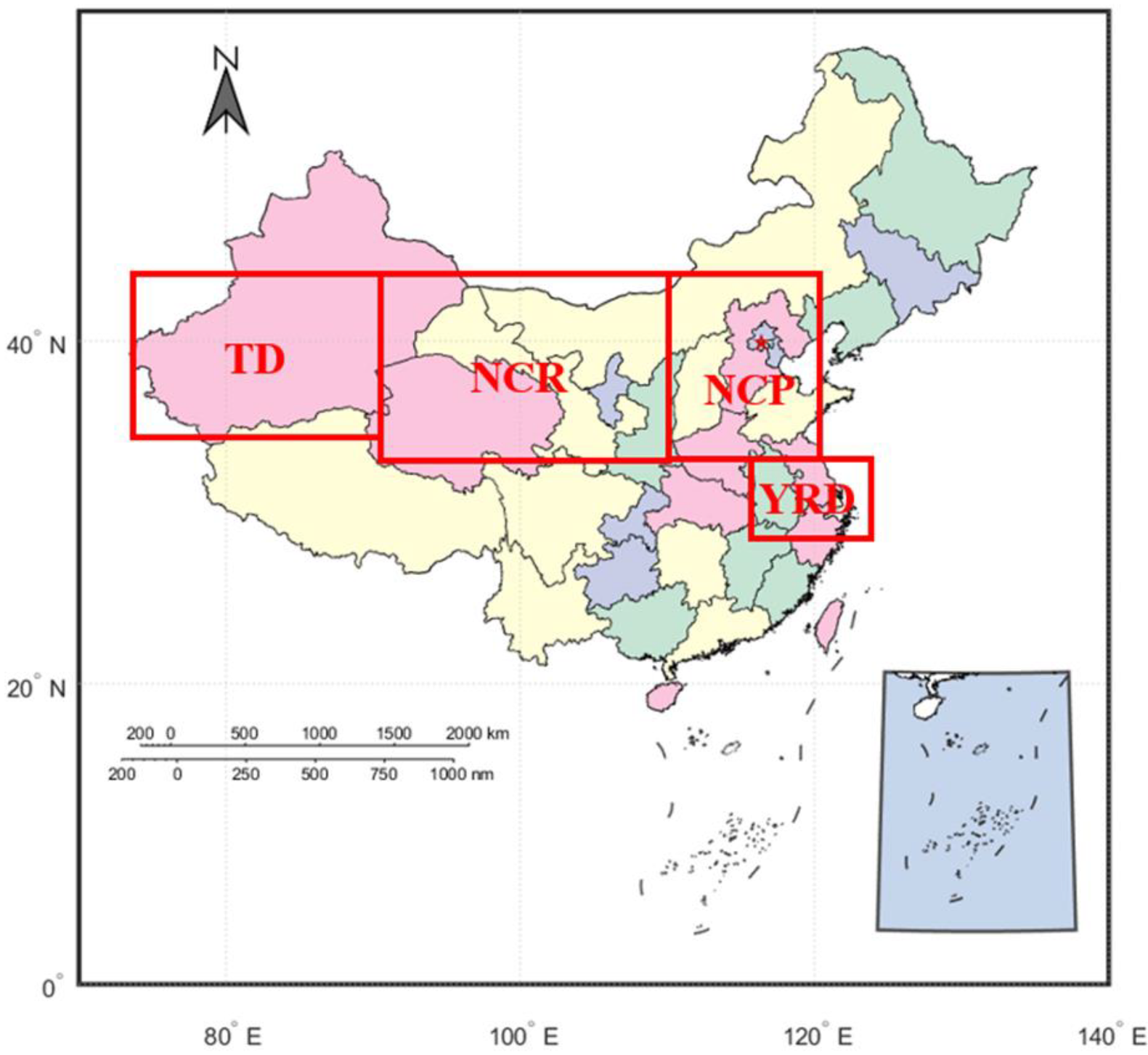

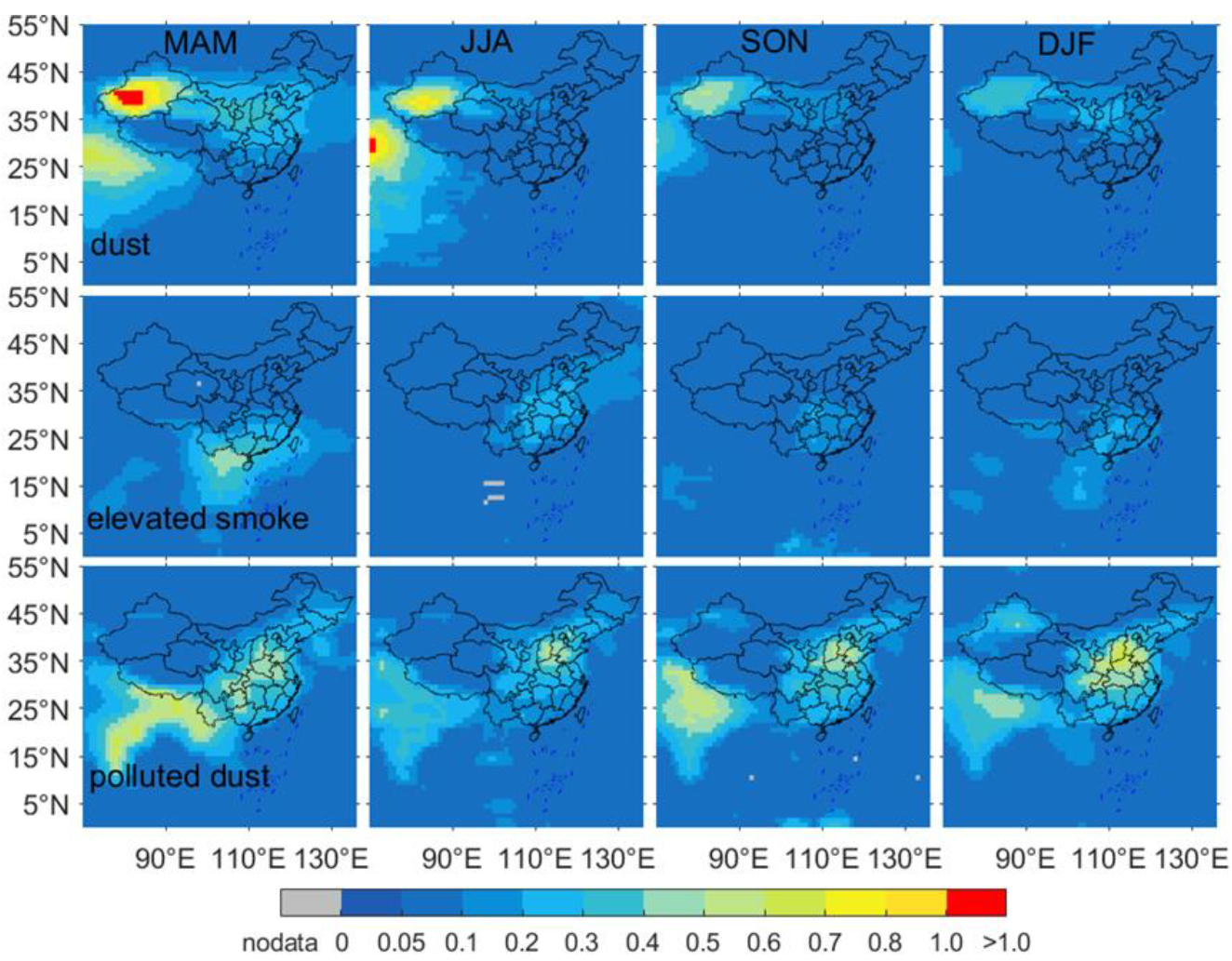
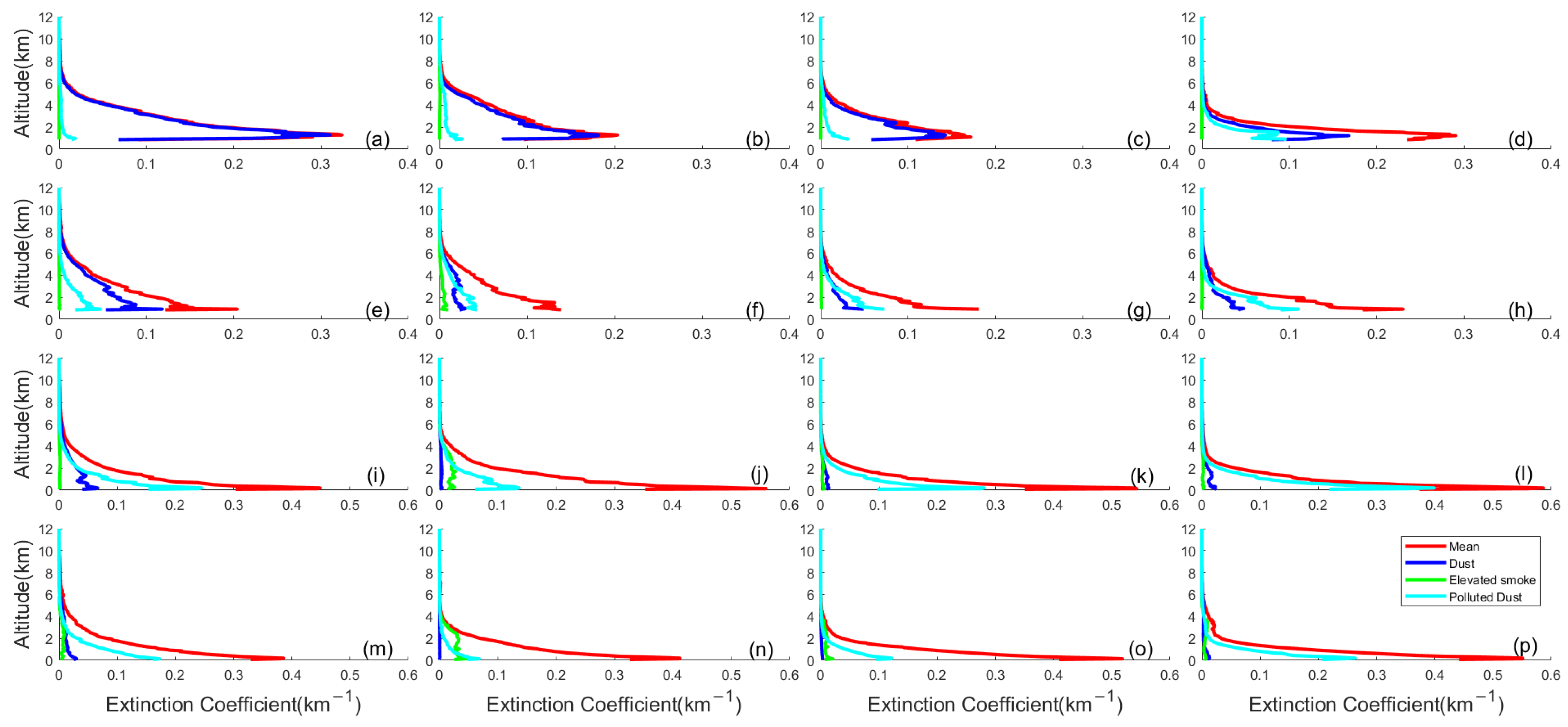
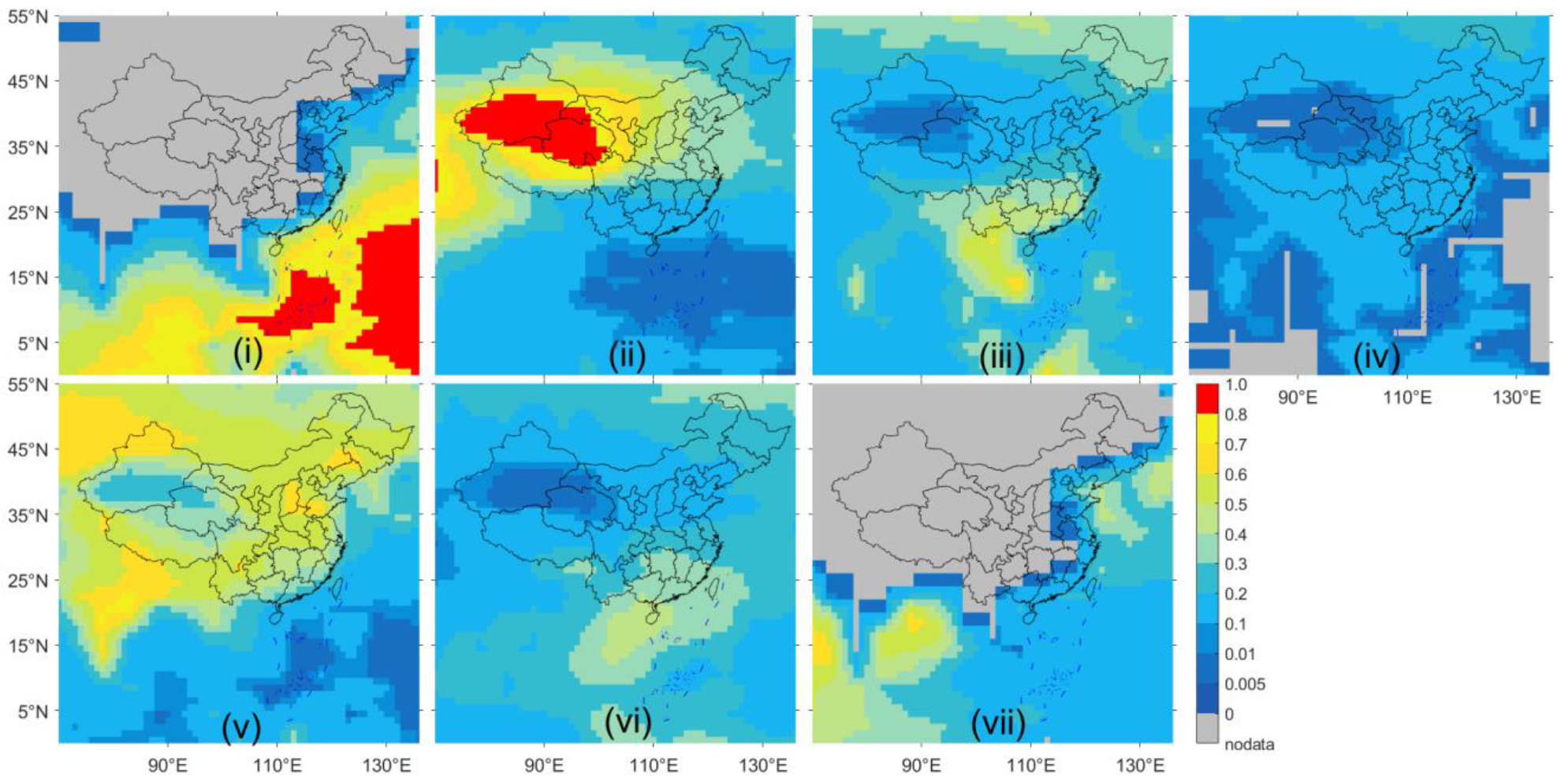
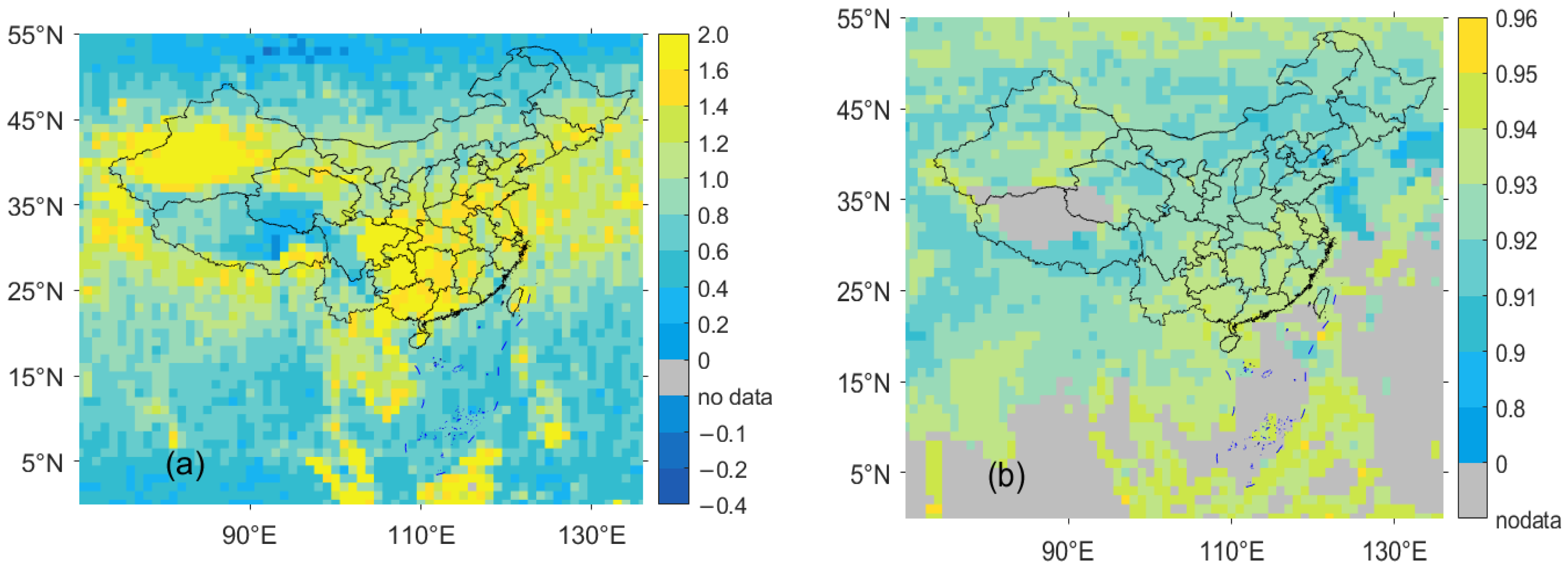


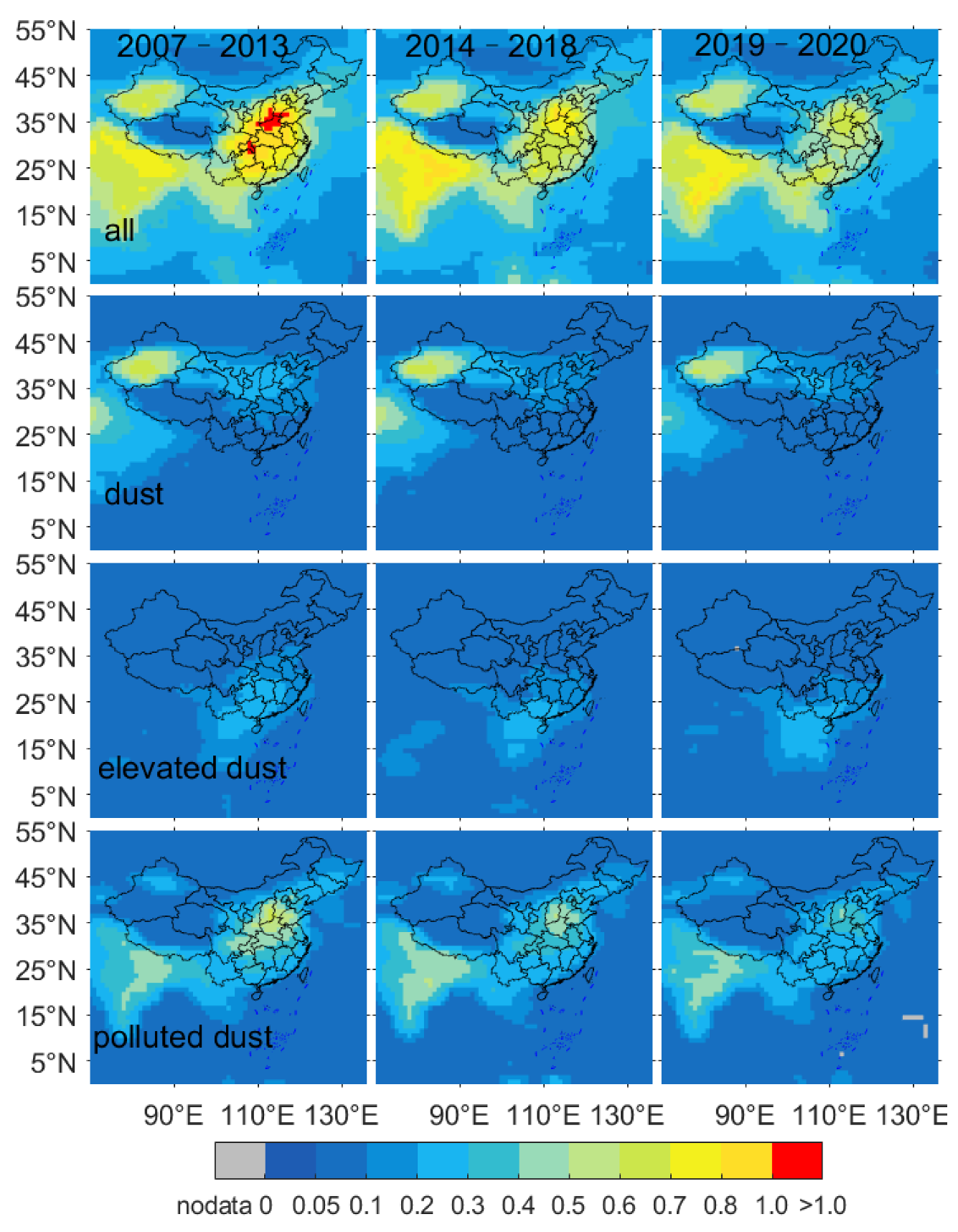

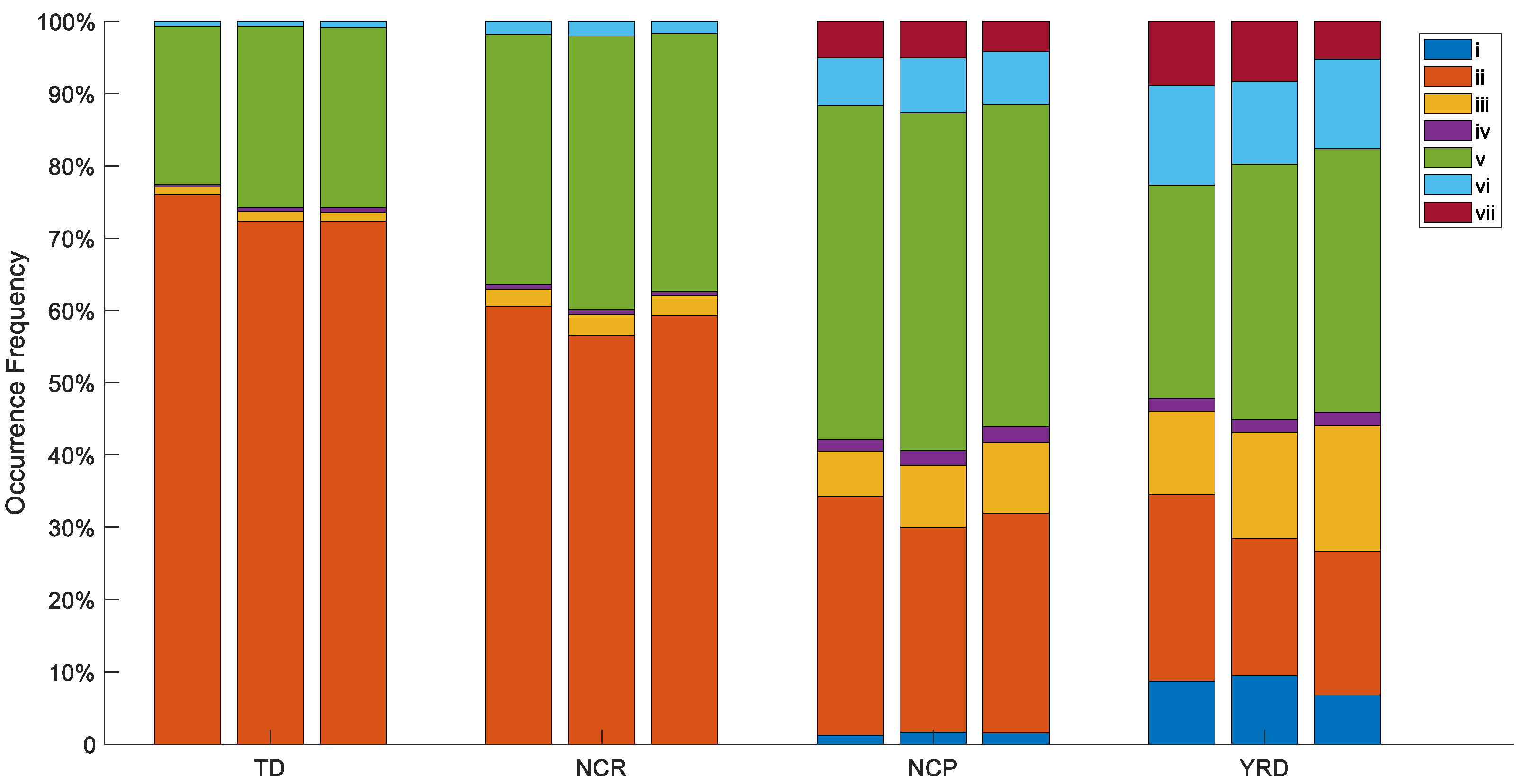
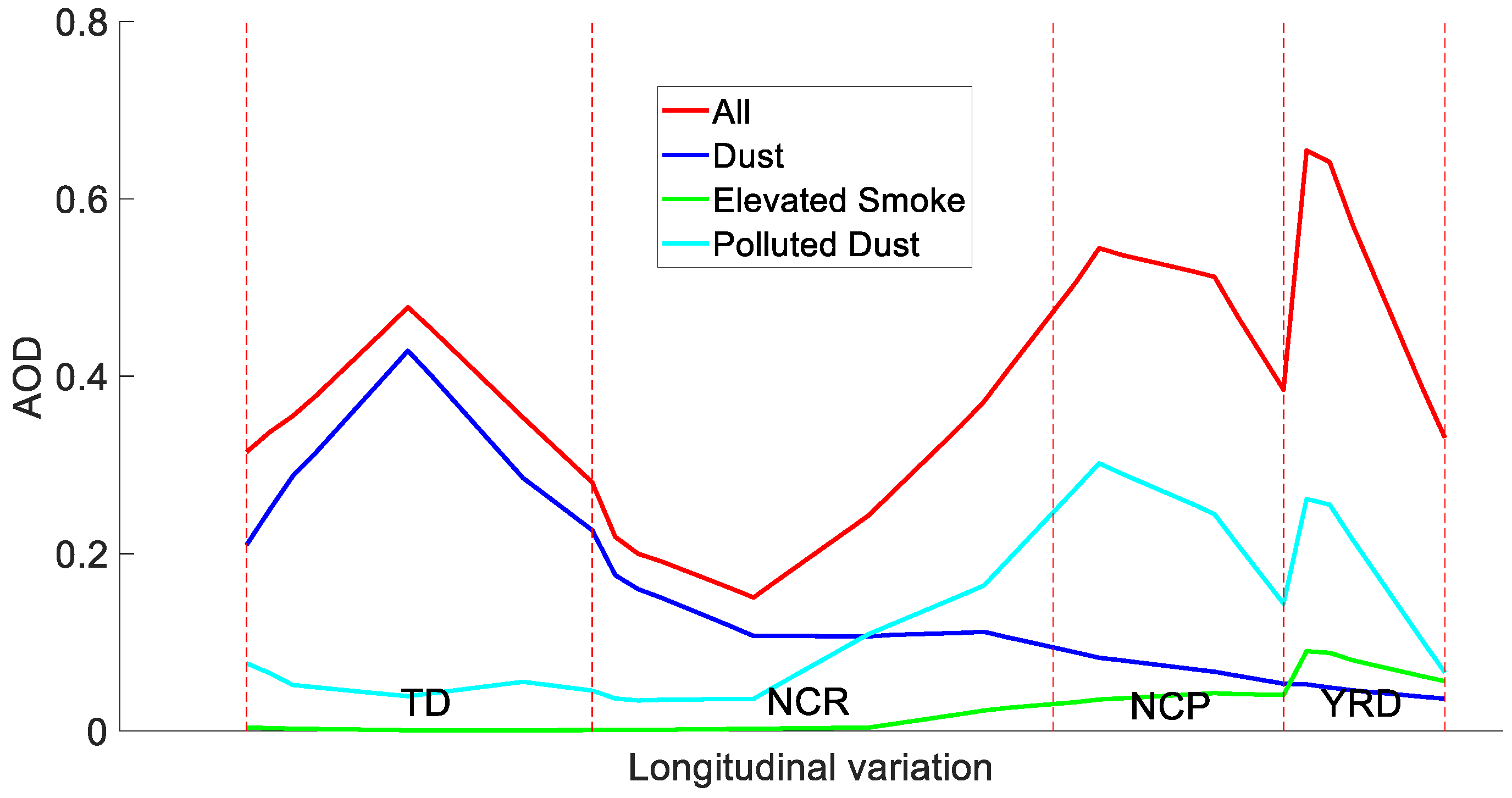


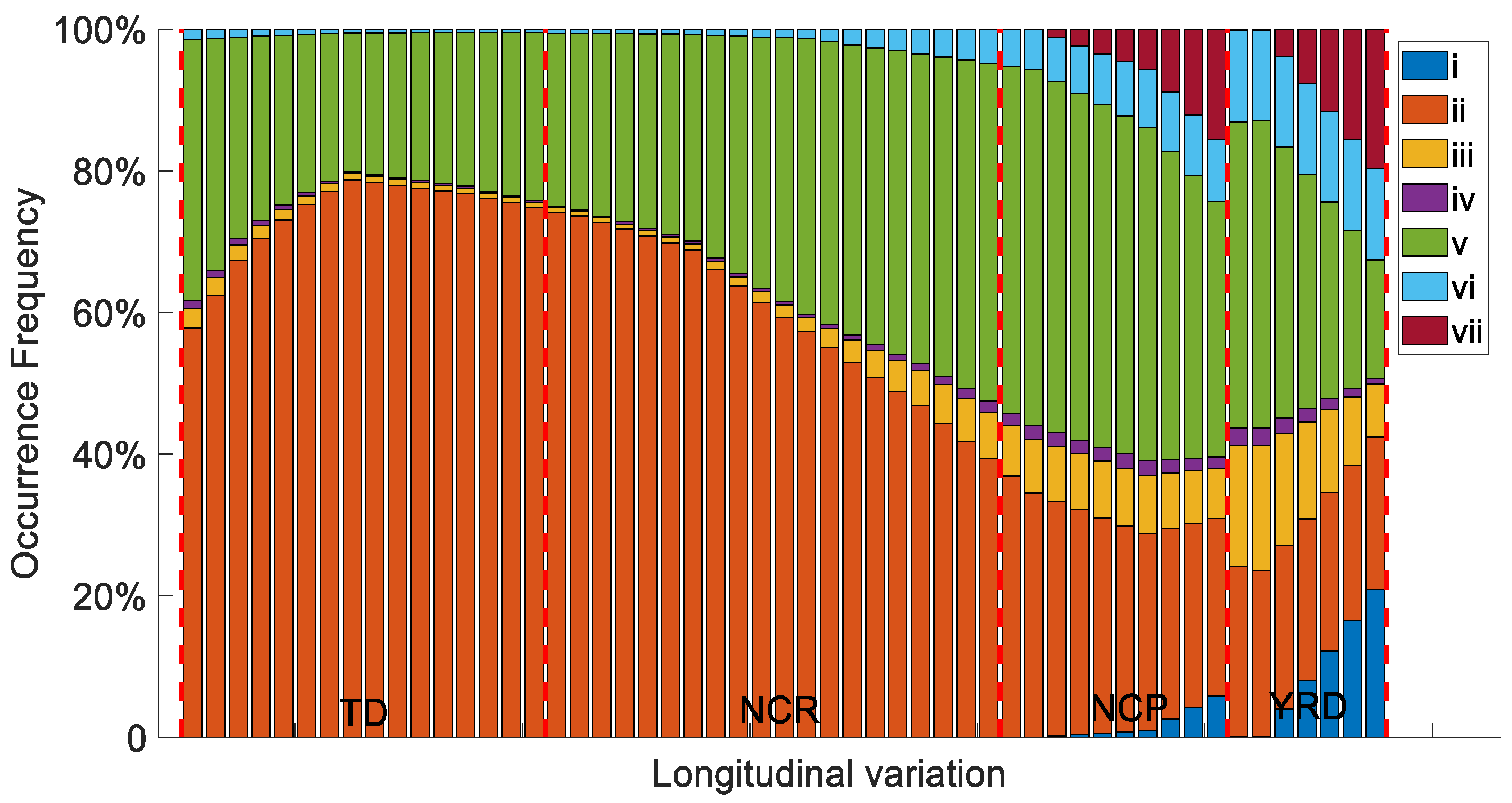
| Region Type | TD | NCR | NCP | YRD |
|---|---|---|---|---|
| MAM JJA SON DJF | MAM JJA SON DJF | MAM JJA SON DJF | MAM JJA SON DJF | |
| all | 0.543 0.400 0.292 0.287 | 0.331 0.269 0.206 0.234 | 0.495 0.590 0.428 0.464 | 0.570 0.508 0.489 0.529 |
| dust | 0.513 0.343 0.242 0.164 (94.4% 85% 83% 57%) | 0.234 0.096 0.072 0.086 (71% 36% 35% 37%) | 0.170 0.027 0.038 0.057 (34% 4.6% 8.9% 12%) | 0.113 0.005 0.019 0.042 (20% 1% 4% 8%) |
| elevated smoke | 9.6 × 10−4 0.004 0.001 6.3 × 10−4 (0.2% 1% 0.3% 0.2%) | 0.004 0.024 0.007 0.002 (1.2% 9% 3.4% 0.9%) | 0.014 0.102 0.022 0.015 (3% 17% 5% 3%) | 0.057 0.145 0.060 0.044 (10% 29% 12% 8%) |
| polluted dust | 0.025 0.045 0.042 0.0905 (4.6% 11% 14% 32%) | 0.081 0.098 0.093 0.120 (24% 36% 45% 51%) | 0.243 0.209 0.236 0.294 (49% 35% 55% 63%) | 0.253 0.090 0.134 0.235 (44% 18% 27% 44%) |
| others | (0.8% 3% 2.7% 10.8%) | (3.8% 19% 16.6% 11.1%) | (14% 43.4% 31.1% 22%) | (26% 52% 57% 40%) |
| Region | EC | EC_Dust | EC_Elevated_Smoke | EC_Polluted_Dust |
|---|---|---|---|---|
| TD | 0–2 km: 0.2190 2–4 km: 0.0784 4–6 km: 0.0193 6–8 km: 0.0028 | 0–2 km: 0.1829 2–4 km: 0.0692 4–6 km: 0.0153 6–8 km: 0.0018 | 0–2 km: 1.27 × 10−4 2–4 km: 3.22 × 10−4 4–6 km: 3.05 × 10−4 6–8 km: 1.17 × 10−4 | 0–2 km: 0.0297 2–4 km: 0.0076 4–6 km: 0.0033 6–8 km: 8 × 10−4 |
| NCR | 0–2 km: 0.1368 2–4 km: 0.0525 4–6 km: 0.0169 6–8 km: 0.0034 | 0–2 km: 0.0535 2–4 km: 0.0280 4–6 km: 0.0117 6–8 km: 0.0024 | 0–2 km: 0.0042 2–4 km: 0.0021 4–6 km: 5.68 × 10−4 6–8 km: 1.52 × 10−4 | 0–2 km: 0.0565 2–4 km: 0.0182 4–6 km: 0.0042 6–8 km: 8 × 10−4 |
| NCP | 0–2 km: 0.2181 2–4 km: 0.0378 4–6 km: 0.0070 6–8 km: 0.0018 | 0–2 km: 0.0258 2–4 km: 0.0096 4–6 km: 0.0031 6–8 km: 0.0011 | 0–2 km: 0.0113 2–4 km: 0.0080 4–6 km: 0.0013 6–8 km: 1.53 × 10−4 | 0–2 km: 0.1109 2–4 km: 0.0153 4–6 km: 0.0024 6–8 km: 5.2 × 10−4 |
| YRD | 0–2 km: 0.2218 2–4 km: 0.0325 4–6 km: 0.0066 6–8 km: 0.0022 | 0–2 km: 0.0131 2–4 km: 0.0055 4–6 km: 0.0030 6–8 km: 0.0011 | 0–2 km: 0.0212 2–4 km: 0.0138 4–6 km: 0.0017 6–8 km: 7.3 × 10−4 | 0–2 km: 0.0798 2–4 km: 0.0093 4–6 km: 0.0018 6–8 km: 4.1 × 10−4 |
| Region | Season | Aerosol Type | ||||||
|---|---|---|---|---|---|---|---|---|
| Clean Marine | Dust | Polluted Continental/ Smoke | Clean Continental | Polluted Dust | Elevated Smoke | Dusty Marine | ||
| TD | Spring | 0 | 0.852 | 0.005 | 0.002 | 0.138 | 0.003 | 0 |
| Summer | 0 | 0.712 | 0.009 | 0.006 | 0.261 | 0.012 | 0 | |
| Autumn | 0 | 0.761 | 0.008 | 0.004 | 0.223 | 0.005 | 0 | |
| Winter | 0 | 0.552 | 0.040 | 0.006 | 0.395 | 0.008 | 0 | |
| NCR | Spring | 0 | 0.752 | 0.007 | 0.003 | 0.230 | 0.008 | 0 |
| Summer | 0 | 0.464 | 0.046 | 0.010 | 0.436 | 0.045 | 0 | |
| Autumn | 0 | 0.536 | 0.031 | 0.007 | 0.412 | 0.015 | 0 | |
| Winter | 0 | 0.542 | 0.028 | 0.005 | 0.419 | 0.006 | 0 | |
| NCP | Spring | 0.004 | 0.493 | 0.027 | 0.010 | 0.394 | 0.029 | 0.043 |
| Summer | 0.027 | 0.128 | 0.158 | 0.037 | 0.425 | 0.200 | 0.024 | |
| Autumn | 0.020 | 0.214 | 0.091 | 0.019 | 0.530 | 0.057 | 0.069 | |
| Winter | 0.013 | 0.276 | 0.062 | 0.015 | 0.542 | 0.028 | 0.064 | |
| YRD | Spring | 0.021 | 0.406 | 0.047 | 0.008 | 0.356 | 0.053 | 0.109 |
| Summer | 0.166 | 0.048 | 0.256 | 0.040 | 0.177 | 0.295 | 0.018 | |
| Autumn | 0.143 | 0.101 | 0.209 | 0.024 | 0.287 | 0.152 | 0.083 | |
| Winter | 0.064 | 0.240 | 0.094 | 0.011 | 0.408 | 0.095 | 0.088 | |
Disclaimer/Publisher’s Note: The statements, opinions and data contained in all publications are solely those of the individual author(s) and contributor(s) and not of MDPI and/or the editor(s). MDPI and/or the editor(s) disclaim responsibility for any injury to people or property resulting from any ideas, methods, instructions or products referred to in the content. |
© 2023 by the authors. Licensee MDPI, Basel, Switzerland. This article is an open access article distributed under the terms and conditions of the Creative Commons Attribution (CC BY) license (https://creativecommons.org/licenses/by/4.0/).
Share and Cite
Luan, K.; Cao, Z.; Hu, S.; Qiu, Z.; Wang, Z.; Shen, W.; Hong, Z. Aerosol Characterization of Northern China and Yangtze River Delta Based on Multi-Satellite Data: Spatiotemporal Variations and Policy Implications. Sustainability 2023, 15, 2029. https://doi.org/10.3390/su15032029
Luan K, Cao Z, Hu S, Qiu Z, Wang Z, Shen W, Hong Z. Aerosol Characterization of Northern China and Yangtze River Delta Based on Multi-Satellite Data: Spatiotemporal Variations and Policy Implications. Sustainability. 2023; 15(3):2029. https://doi.org/10.3390/su15032029
Chicago/Turabian StyleLuan, Kuifeng, Zhaoxiang Cao, Song Hu, Zhenge Qiu, Zhenhua Wang, Wei Shen, and Zhonghua Hong. 2023. "Aerosol Characterization of Northern China and Yangtze River Delta Based on Multi-Satellite Data: Spatiotemporal Variations and Policy Implications" Sustainability 15, no. 3: 2029. https://doi.org/10.3390/su15032029
APA StyleLuan, K., Cao, Z., Hu, S., Qiu, Z., Wang, Z., Shen, W., & Hong, Z. (2023). Aerosol Characterization of Northern China and Yangtze River Delta Based on Multi-Satellite Data: Spatiotemporal Variations and Policy Implications. Sustainability, 15(3), 2029. https://doi.org/10.3390/su15032029









